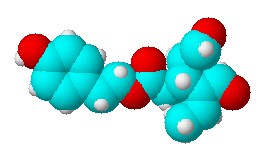
As a chemistry student, I was always taught to flute my filter papers, but a heated debate about another method of using your filter paper is raging on the Chemed-l discussion group about why others fold their paper and then tear off the corner. Hal Harris University of Missouri-St. Louis reckons the little corner tear improves the filtering process and also speeds it up significantly. So much so, he says, that “Over a lifetime in chemistry, I’m sure that this has saved me a cumulative 20 msec, at least.”
Meanwhile, here’s the standard method of fluting filter paper. The technique is used when you wish to separate a liquid and a solid, keeping the liquid and discarding the solid. The specific arrangement of folds (flutes) in the filter paper will allow the liquid to pass through it very quickly and at the same time provide a large surface area on which to collect the solid impurities.
 Oleocanthal structure
Oleocanthal structure Porn star names seem to be the modern trendy equivalent of star signs. People at parties ask you what your porn star name might be, and others have a useful little formula for generating them. First name comes from the name of your first pet, say. Lucky. And, the last name, your mother’s maiden name. Cocker. Hence my PSN might be Lucky Cocker. My wife’s is Goldie Black…
Porn star names seem to be the modern trendy equivalent of star signs. People at parties ask you what your porn star name might be, and others have a useful little formula for generating them. First name comes from the name of your first pet, say. Lucky. And, the last name, your mother’s maiden name. Cocker. Hence my PSN might be Lucky Cocker. My wife’s is Goldie Black… Apparently, only 50% of cats respond to catnip. Catnip sensitivity is inherited, says Carolyn McDaniel, a veterinarian at the Feline Health Center at Cornell University in Ithaca, NY.
Apparently, only 50% of cats respond to catnip. Catnip sensitivity is inherited, says Carolyn McDaniel, a veterinarian at the Feline Health Center at Cornell University in Ithaca, NY.